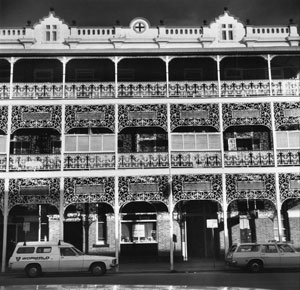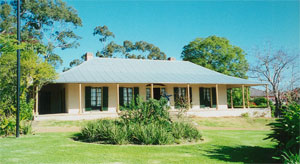The search for a distinctive Australian architectural style

Simply sign up to the Life & Arts myFT Digest -- delivered directly to your inbox.
Writing in The Bulletin magazine in October 1989, Harry Seidler, the architect who brought international modernism to Australia, said the Aussie style was the successful response “to climate and our informal way of life”, rather than anything identifiable. This was a faintly ironic view given his first Australian commission in 1950. The Rose Seidler House, a rectangular box dropped into the bushy, undeveloped Sydney suburb of Wahroonga, was a bold expression of modernism. It reflected Seidler’s belief that the style suited any location in any environment.
This modernist masterpiece kick-starts Karen McCartney’s first book, 50/60/70 Iconic Australian Houses, which – along with the follow-up, 70/80/90 Iconic Australian Houses – reviews a selection of house projects over the past 60 years.
The books form the basis of a new exhibition at the Museum of Sydney. Curated by McCartney and presented in conjunction with Sydney Living Museums and the Architecture Foundation Australia, Iconic Australian Houses is billed as showing work that reveals the emergence of a “distinctively Australian approach to home design”.

After the second world war, where the exhibition begins, McCartney says: “Young architects began to travel, to read international architecture journals, and the desire to create houses that were appropriate to the Australian landscape and climate gained traction. The coming down of internal walls and the conscious engagement with exterior spaces as glazed walls and continuous use of materials from inside to out gained popularity.” It is an expression of an informal lifestyle that chimes with Seidler’s view.
Architect Peter McKenzie, of Jackson Teece’s Sydney office, questions whether Australia has ever developed a distinctive approach to home design. “It seems to me we import world trends. My view about Australian architecture, domestic particularly, is that it is all copyist. The pattern in the interwar years followed that set in the colonial period: migrating architects imported a style (Leslie Wilkinson, Walter Burley Griffin), or Australian architects travelled the ‘Grand Tour’ to the US and Europe – sometimes on a scholarship – and returned with a style.”

Building types like the homestead with wide verandas and French doors are inextricably linked to Australia and the romance of the continent’s vast and remote interior. Yet in truth, as McKenzie observes, the tradition was imported. The builder of the earliest homestead, Experiment Farm Cottage on the outskirts of Sydney – thought by some to have been completed in 1790, while others believe it dates from 1835 – had spent 10 years in India where single-storey bungalows with wide verandas and slim double doors were commonly used to provide shade and breeze. Coupled with fashionable Georgian elements – the slender columns, elliptical front-door arch, and simple symmetry that came across with the first settlers in 1788 – it is a style that suited the Australian climate and soon spread across the colony.
This trend for adapting the architectural language of Britain or other countries of the empire continued as the new colony developed and lives and homes were established.

Abercrombie House in rural New South Wales, a vast mansion dating to the 1870s, is described by the National Trust as Jacobean in style. It has Scottish baronial hints in its gables, gothic entrance, and elegant cast-iron veranda. In fact, it is a glorious hotchpotch. It was built by James Stewart on land given to his father, William, who arrived in the penal colony in 1825 and served as lieutenant-governor from 1825 to 1827.
Belltrees is another large rural mansion built in about 1907. Adapted to the dry heat of rural New South Wales with a two-storey veranda, its basic external design is not dissimilar to Edwardian villas found in the coastal towns of Sussex, southern England. Yet where timber is used in the verandas of Eastbourne, cast-iron screens were utilised in Australia.
In many cases, though, houses and cottages in New South Wales would not have looked out of place in England or Scotland.
Governor Lachlan Macquarie’s wife had a keen interest in building and brought pattern books containing instructions for constructing and designing with her to Sydney. Today, picturesque gothic villas can be found along the city’s shoreline. The best examples are Lindesay and Carthona, both completed in the mid-19th century. Their designs spring straight out of John Claudius Loudon’s An Encyclopedia of Cottage, Farm, and Villa Architecture and Furniture.

A striking yet by no means defining feature of Australian buildings are the cast-iron balconies and verandas of the urban terraced houses. In Melbourne, iron-lace ornamentation became elaborate, decorative and widespread during the boom that followed the discovery of gold in the 1850s. Cast iron is seen again in the prefabricated buildings imported from Britain to Australia to cope with the dramatic population rise in the mid-19th century. One of the most elaborate was the Corio Villa, shipped over from Edinburgh in the 1850s. Its cast iron is so decorative it is hard to believe it arrived in bits and pieces.
It is in the tropical north of Queensland where the best adaptations took place. The single-storey bungalow of the early days of the colony is tweaked to suit the hot, humid climate of the north. Peter McKenzie goes further and believes that, while there may not be “a clearly distinguishable Australian style, the one possible exception is the timber houses of Queensland”. Raised above the ground on timber stilts to allow air to flow and cool underneath the building, it was an approach that developed in the latter part of the 19th century and only petered out in the 1950s. Yet, while being an ingenious response to climate, these stick houses express a method of construction more than a distinctive style.

It was not until the centennial celebrations of 1888 that a desire to create a distinctive Australian style of building took hold. “The celebrations gave rise to a nationalistic spirit that you can see in many of the motifs used in bas-relief and stained glass, Australian things like the coat of arms, lyrebirds, kookaburras on what were essentially variations of a Queen Anne-type house”, says Jacqui Goddard, a heritage architect and partner at Sloss & Goddard.

Known as the “federation” style, the term was only coined by historians during the 1970s, and a multitude of variations exist: federation arts and crafts; federation Queen Anne; federation filigree; and federation bungalow.
Today, the federation bungalow inspired by US designs defines the character (where they have escaped mutilation or demolition) of many city suburbs, especially Sydney’s. Yet it is debatable whether this is anything more than a subtle hint of Australian character rather than a definitive style. In any case, does it matter? Architecture is a tradition, so doesn’t everyone copy? Today, domestic architecture produced in Australia is bold and confident. It may still be derivative, but who doesn’t hunger after a beautifully crafted Glenn Murcutt house? Whether or not the country has a distinctive approach to home design or not, one thing is for sure: its recent and distant architectural heritage is rich and diverse and deserves to be celebrated.
‘Iconic Australian Houses’ runs at the Museum of Sydney until August 17; sydneylivingmuseums.com.au
Photographs: PV Collection/Alamy; Sydney Living Museums; F Watson; RIBA; Clifford Smith; Chris Morgan
Comments